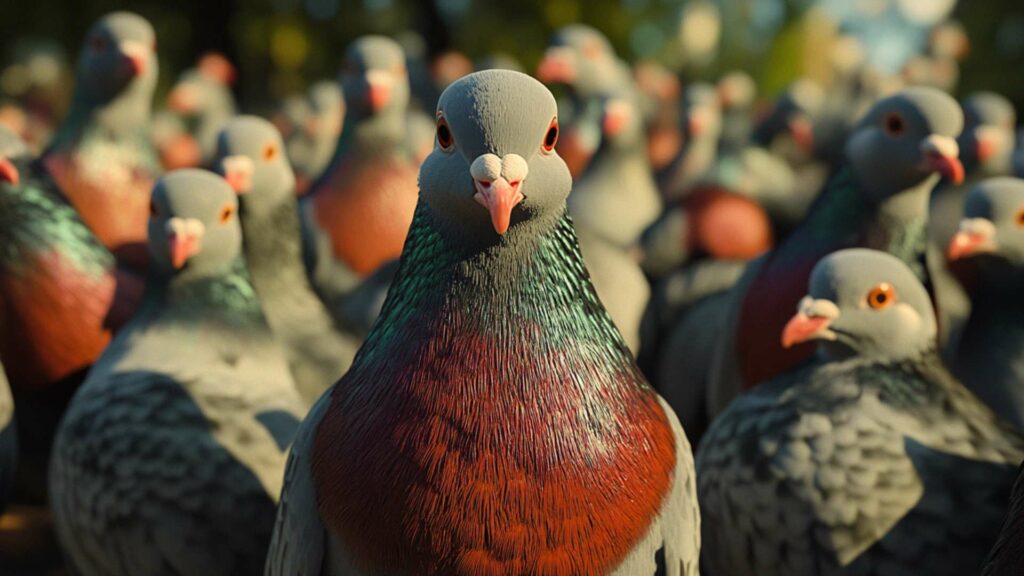Pigeon fever, scientifically known as Corynebacterium pseudotuberculosis, is an infectious disease that primarily affects horses. This condition gets its peculiar name from the characteristic swelling it causes in the horse’s pectoral region, which resembles a pigeon’s breast. Pigeon fever has been recognized for centuries and continues to pose significant health concerns for equine populations worldwide.
The main culprit behind pigeon fever is the pseudotuberculosis bacteria. This bacterium can infect horses through various means, including flies carrying the organisms or direct contact between infected and healthy animals.
Additionally, environmental contamination with the bacteria can contribute to its spread. While pigeon fever primarily affects horses, it can also affect other livestock species like cattle or goats.
Historical Background and Prevalence

Pigeon fever is not a newcomer to the equine world; in fact, its historical presence can be traced back several hundred years. The first documented cases were reported in the late 1800s in California during a large outbreak among working horses. Over time, pigeon fever spread across North America and later expanded its reach globally.
Today, pigeon fever remains prevalent in various regions around the world. Outbreaks are more common in warm climates where flies thrive year-round but can still occur in cooler areas during summer months when fly populations peak.
Areas with high horse densities or those where young horses are frequently introduced have an increased risk of experiencing outbreaks. Now that we understand what pigeon fever is and delve into its causes and transmission methods as we continue exploring this fascinating topic further.
Causes and Transmission of Pigeon Fever

Pigeon fever, scientifically known as Corynebacterium pseudotuberculosis, is caused by a highly contagious bacterial infection. This infectious bacteria is primarily responsible for the development of abscesses in horses.
Corynebacterium pseudotuberculosis can survive in various environmental conditions, making it quite resilient. It has a predilection for warm and dry climates, which explains why cases of pigeon fever are more commonly seen in regions like Western Canada and other dryland areas.
Modes of Transmission – Flies, Direct Contact, Contaminated Objects
Pigeon fever spreads through multiple modes of transmission. The most common vector is flies, particularly those that thrive in warmer climates.
These insects play a crucial role in disease transmission as they carry infected material from one horse to another when feeding on contaminated soil or landing on open wounds, or open sores. Direct contact with an infected horse is another significant means of transmission.
When healthy horses come into contact with the pus from external abscesses or nasal secretions from an infected horse, the bacteria gain access to their system. Contaminated objects such as grooming tools, tack equipment, or even shared water troughs can also transmit the bacteria if they come into contact with exposed skin on a horse.
It’s important to note that while rare, pigeon fever most horses can also affect other animals like cattle and goats. By understanding these causes and modes of transmission associated with pigeon fever in horses—alongside its bacterial agent—veterinarians can make an accurate diagnosis and implement appropriate treatment plans to control the spread of this disease effectively and minimize its impact on affected animals’ health.
Clinical Signs and Symptoms
One of the most recognizable signs of pigeon fever in horses are the external abscesses that develop in affected horses. These external abscesses typically occur in the pectoral region, commonly known as the pigeon’s breast, although they can also appear on the abdomen or limbs handling infected horses.
Initially, you may notice a small, firm lump under the skin. Over time, this lump becomes larger and starts to feel soft and fluctuant as it fills with pus.
The abscess continues to grow until it reaches its peak size before it eventually ruptures or drains naturally. This process can take several weeks, during which time you’ll need to carefully monitor your horse for any changes.
While external abscesses are more common in cases of pigeon fever, internal abscesses can also develop in some infected horses. These internal abscesses are a less frequent but potentially severe complication of the disease. They occur when the pseudotuberculosis bacteria spreads throughout the horse’s body via their bloodstream or lymphatic system.
Once inside, these bacteria can cause deep abscesses within vital organs such as the liver or lungs. Internal infection or abscessation may result in more generalized symptoms such as respiratory disease or abdominal pain and can be life-threatening if not promptly addressed by a veterinarian.
Swollen limbs or chest area – characteristic “pigeon-like” appearance
Another distinctive sign of pigeon fever is swelling in the limbs or chest area that gives affected horses a peculiar “pigeon-like” appearance. This swelling is due to inflammation caused by bacterial infection within deep tissues, leading to edema and an enlargement of affected body parts.
Limb infections are often seen when horses contract a specific strain of the pseudotuberculosis bacteria, known as the Corynebacterium pseudotuberculosis equi. In some cases, the limb infection and swelling can be quite extensive, making it difficult for horses to move comfortably and resulting in lameness.
It’s crucial to provide appropriate treatment and supportive care to alleviate discomfort and aid in a speedy recovery. Overall, recognizing the signs of pigeon fever is key to initiating proper treatment and preventing potential complications in infected horses.
Diagnosis of Pigeon Fever in Horses

When it comes to diagnosing pigeon fever in horses, a thorough physical examination is crucial. The veterinarian will assess the horse’s overall health, paying close attention to any external or internal abscesses, or swollen areas. They will palpate the horse’s body, especially the lymph nodes, to detect any abnormalities.
Pigeon fever commonly manifests as painful abscesses in the pectoral region or along the limbs, giving them a distinct “pigeon-like” appearance. Moreover, these abscesses can vary in size and severity, ranging from small lumps to large masses filled with pus.
Laboratory tests – bacterial culture, blood work, ultrasound
While physical examination provides valuable insights into possible pigeon fever cases, laboratory tests are essential for confirming the diagnosis definitively. One of the primary diagnostic tools is a bacterial culture. By isolating and identifying the Corynebacterium pseudotuberculosis bacteria responsible for pigeon fever infection, veterinarians can confirm its presence in an infected horse.
Blood work is another critical aspect that aids in diagnosis by detecting elevated white blood cell counts and other markers of infection. Ultrasound imaging plays a pivotal role in assessing internal and external abscesses that might not be apparent during physical examination alone.
Certain cases of pigeon fever may involve internal infections affecting organs such as the liver or spleen. By employing ultrasound technology, veterinarians can visualize these hidden internal abscesses and determine their size and location accurately.
By combining physical observation with laboratory testing techniques like bacterial culture, blood work analysis, and ultrasound imaging when necessary; veterinarians can make a definitive diagnosis regarding pigeon fever in horses. This comprehensive approach ensures accurate identification of this contagious disease while ruling out other conditions that may have similar clinical signs or symptoms.
Treatment Options for Pigeon Fever
When it comes to treating pigeon fever in horses, antibiotics play a crucial role. The primary antibiotic used is usually penicillin or trimethoprim-sulfamethoxazole.
These medications are effective in combating the bacterial agent responsible for the infection, Corynebacterium pseudotuberculosis. Treatment typically lasts for several weeks to ensure complete eradication of the bacteria from the horse’s body.
However, it’s important to note that not all cases require antibiotic therapy. Equine practitioners evaluate each individual case and consider factors like abscess location, severity of clinical signs, and presence of internal infection before deciding on antibiotic treatment.
One of the most noticeable and painful aspects of pigeon fever in horses is the formation of external abscesses – those painful swellings on their chest or hind limbs, that resemble a pigeon’s breast. Abscesses may naturally rupture, releasing pus and providing relief to affected horses; this is especially common in cases where the horses with internal abscesses that are located on the chest area or hind limbs.
However, if an abscess does not rupture naturally or if it is causing severe lameness or discomfort for your horse to horse contact, equine practitioners may opt for surgical drainage. This involves making a small incision into the horses with internal abscesses, under sterile conditions to allow proper drainage.
Pain management and supportive care
During treatment for pigeon fever, managing your horse’s pain and providing supportive care are essential parts of their recovery process. Horses experiencing severe discomfort may require nonsteroidal anti-inflammatory drugs (NSAIDs) such as phenylbutazone (bute) to alleviate pain and reduce inflammation.
Additionally, applying warm compresses or poultices to the affected areas can help soothe your horse and promote healing. Good quality care, including proper nutrition, adequate rest, and a clean environment, is pivotal in supporting your horse’s immune system and overall well-being during their recovery journey.
Treating pigeon fever in horses involves a multifaceted approach. Antibiotics are effective in eradicating the bacterial infection caused by Corynebacterium pseudotuberculosis, while drainage of abscesses may be necessary for cases where natural rupture does not occur or severe lameness is present.
Pain management and supportive care are vital for your horse’s comfort and recovery. Remember to consult with a veterinarian for a definitive diagnosis and tailored treatment plan based on the specific needs of your horse.
Prevention Strategies for Pigeon Fever in Horses
When it comes to preventing the transmission of pigeon fever in horses, effective fly control is essential. Flies play a significant role in spreading the bacterial infection caused by Corynebacterium pseudotuberculosis.
Therefore, implementing robust fly control measures is crucial to protect your equine companions. First and foremost, using insecticides specifically designed for controlling flies can significantly reduce the risk of infection.
These products come in various forms such as sprays, wipes, and spot-on treatments. Applying them regularly on horses’ bodies and their surrounding environment helps repel and kill flies that may carry the pseudotuberculosis bacteria.
Additionally, utilizing fly repellents can provide an extra layer of defense against these pesky insects. These repellents can be applied directly to horses or used as environmental sprays around stables and paddocks.
By repelling flies from landing on horses’ skin, these products decrease the chances of disease transmission. Stable management practices also play an important role in preventing pigeon fever.
Maintaining cleanliness within barns and paddocks is crucial since flies are attracted to accumulations of manure and decaying organic matter. Regular removal of manure piles, proper disposal of standing water sources that attract breeding mosquitoes (a common method used by some species of flies), and maintaining clean bedding all contribute to reducing fly populations around horses.
Vaccination options – efficacy and limitations
Vaccination against pigeon fever can be considered as an additional preventive measure for your equine companions. However, it’s important to note that currently available vaccines offer limited protection against pigeon fever treated certain strains of Corynebacterium pseudotuberculosis. Vaccines work by stimulating the horse’s immune system to produce antibodies that fight off the infection.
While vaccination may not completely prevent the disease, it can potentially reduce the severity and duration of symptoms if the horse does get infected. Equine practitioners generally recommend vaccinating horses in regions where pigeon fever is prevalent or when there have been outbreaks reported nearby.
Vaccination protocols typically involve an initial series of two doses given a few weeks apart, followed by annual boosters to maintain immunity. It’s important to keep in mind that while vaccines can aid in minimizing the risk of infection, they are not foolproof.
Environmental factors, such as high fly populations and close proximity to infected horses, can still increase the chances of contracting pigeon fever even in vaccinated animals. Therefore, a multi-faceted approach combining vaccination with thorough fly control measures and proper stable management practices is crucial for reducing the risk of pigeon fever in horses and maintaining their overall health.
Uncommon Facts about Pigeon Fever in Horses
Unusual cases worldwideWhen we think of pigeon fever, we often associate it with regions like the southwestern United States, where it is more commonly reported. However, there have been some surprising cases documented in other parts of the world as well. For instance, in Western Canada, there have been sporadic outbreaks of pigeon fever among horses despite its rarity in that region. These cases highlight the ability of the pseudotuberculosis bacteria to adapt and manifest even in areas not typically associated with this equine health concern. Such instances emphasize the importance of being vigilant and knowledgeable about pigeon fever regardless of your geographical location.
Lesser-known symptoms or complicationsWhile many are familiar with the classic signs of pigeon fever such as external abscesses or swollen limbs resembling a “pigeon-like” appearance, there are lesser-known symptoms and complications that can occur as well. One such complication is ulcerative lymphangitis – an infection that affects the lymphatic vessels causing severe lameness and swelling particularly in the pectoral region or chest region of affected horses. Another rare but possible complication includes deep abscesses within vital organs like the mammary gland or abdominal cavity, leading to systemic illness and abdominal pain. It is important to remember that accurate diagnosis by a veterinarian is crucial when encountering any signs of pigeon fever or related complications as these clinical signs can mimic other conditions. By staying informed about these uncommon facts surrounding this common form of pigeon fever in horses, we can better recognize potential variations within this equine health issue and ensure timely intervention for our beloved equine companions.
Conclusion on Pigeon Fever in Horses
Pigeon fever may be a formidable foe for horse owners, but armed with knowledge and the implementation of effective prevention strategies, it is possible to mitigate the risk. By practicing good fly control measures and maintaining a clean environment, horse owners can greatly reduce the chances of their equine companions contracting this bacterial infection.
Additionally, staying vigilant about recognizing and promptly treating any clinical signs will contribute to better outcomes. Regular communication with equine practitioners is essential in ensuring appropriate treatment protocols.
With advancements in veterinary medicine, equine practitioners can now diagnose pigeon fever more definitively through laboratory tests such as bacterial cultures and ultrasound imaging. This enables them to provide more targeted treatment options for affected horses.
Antibiotics have proven effective in combating the initial infection itself, while drainage of external and internal abscesses aids in the healing process. Importantly, many horses recover fully from pigeon fever with appropriate care.
Building Herd Immunity: A Silver Lining
While pigeon fever may seem like a daunting challenge, there is reason for optimism. Horses that have battled this infection develop immunity against future encounters with Corynebacterium pseudotuberculosis.
As a result, over time, herds can develop a form of collective protection known as herd immunity, which reduces the overall prevalence of pigeon fever within a population of horses. Although pigeon fever poses risks to our beloved equine companions, by understanding what it is and implementing effective prevention strategies we can minimize its impact on horse health.
Equine practitioners play a critical role in diagnosing and treating affected horses appropriately. With continued research and advancements in veterinary medicine along with increased awareness among horse owners, we can ensure that pigeon fever becomes an increasingly manageable condition, allowing horses to live long, healthy lives.
Keep Pigeons Away with D-Termination: Las Vegas’ Top Pest Control Choice!

If pigeon problems are causing you trouble, D-Termination is here to assist. Our skilled team specializes in pigeon deterrence and the rejuvenation of cleanliness and integrity in your environment. Bid farewell to pigeons by opting for D-Termination’s highly effective pest control today!
Reach out to us at 702-919-6310 or visit dtermination.com to schedule your pigeon control service and regain your space from these unwelcome pests.
Frequently Asked Questions:
Symptoms of pigeon fever in horses may include abscesses, fever, and lameness.
Treatment for pigeon fever in horses often involves drainage of abscesses and antibiotics.
Pigeon fever in horses is typically caused by the bacterium Corynebacterium pseudotuberculosis.
Yes, pigeon fever can be contagious between horses, primarily through direct contact or contaminated equipment.








